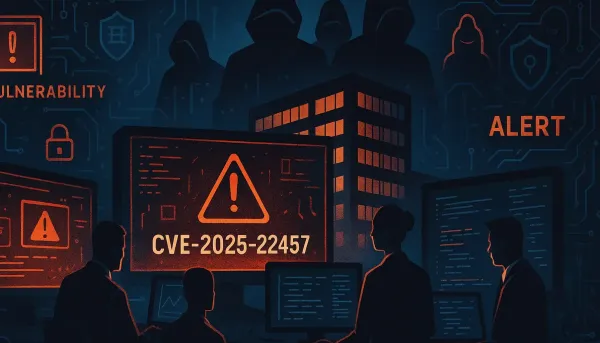
Critical Analysis of Ivanti Connect Secure Vulnerability CVE-2025-22457
The rise of cyber threats targeting critical infrastructure has escalated at an alarming rate, compelling organizations to heighten their security posture. Recently, a significant vulnerability was uncovered in Ivanti’s Connect Secure product, tracked as CVE-2025-22457, marking an urgent call for cybersecurity professionals to fortify their defenses. This vulnerability, which allows remote unauthenticated attackers to execute arbitrary code, epitomizes the types of threats faced in today’s digital landscape. This blog post delves into the technical intricacies of the CVE-2025-22457 vulnerability, its exploitation, implications, and strategic mitigative actions.
Vulnerability Overview
CVE-2025-22457 is classified as a stack-based buffer overflow (CWE-121), characterized by its CVSS score of 9.0, indicating critical severity. Specifically, the flaw exists in:
- Ivanti Connect Secure (versions 22.7R2.5 and earlier)
- Pulse Connect Secure (versions 9.1R18.9 and prior, with end-of-support since December 31, 2024)
- Ivanti Policy Secure (versions 22.7R1.3 and prior)
- ZTA Gateways (versions 22.8R2 and prior)
The root cause of the vulnerability lies in improper handling of user input, leading to an exploitable buffer overflow condition. Attackers can leverage this vulnerability to gain full control over affected systems without any form of authentication, thereby jeopardizing sensitive organizational data and operations.
Active Exploitation Landscape
CISA added CVE-2025-22457 to its Known Exploited Vulnerabilities (KEV) catalog on April 4, 2025, following evidence of active exploitation in the wild, predominantly attributed to the threat actor UNC5221. This group has previously demonstrated sophisticated malware development capabilities, employing custom-developed tools such as:
- TRAILBLAZE: An in-memory dropper facilitating the initial exploitation of vulnerable systems.
- BRUSHFIRE: A passive backdoor designed for stealthy persistence.
- SPAWN malware suite: A sophisticated collection of tools aimed at various malicious activities, including log tampering and data exfiltration.
Recent Attack Patterns
The latest reports indicate that exploitation began in earnest around mid-March 2025. This surge in activity is believed to be a consequence of UNC5221 analyzing the February patch released by Ivanti, subsequently reverse-engineering mechanisms within it to exploit earlier vulnerable versions. Threat intelligence firms, such as Mandiant, have confirmed that this type of exploitation underscores the startling capability of threat actors to adapt quickly to defensive measures.
Recommendations for Organizations
-
Immediate Patching: Organizations are strongly advised to upgrade to Connect Secure version 22.7R2.6 or later versions of affected products. Given the active exploitation, timely patching should be the number one priority.
-
Conduct Comprehensive Threat Assessments: Use Ivanti’s Integrity Checker Tool (ICT) to identify potential compromises. Key indicators of compromise may include unexplained web server crashes or strange logs pointing toward failure in normal operations.
-
Factory Resets and Clean Imaging: For systems suspected of being compromised, a factory reset should be performed. Utilizing clean images will ensure that backdoors or other malicious software are completely purged.
-
Isolate Affected Systems: Isolate any instances that may have been compromised. Disconnecting them from the network can contain potential lateral movement.
-
Robust Monitoring and Auditing: Regularly audit privileged accounts and monitor authentication services to detect any anomalies.
-
Engage with Cybersecurity Authorities: In the event of confirmed compromises, it is crucial to report incidents immediately to CISA as well as coordinate responses with Ivanti to ensure services can be restored securely.
Conclusion
The infiltration of critical vulnerabilities such as CVE-2025-22457 serves as a stark reminder of the ever-evolving landscape of cyber threats facing modern enterprises. Given the sophisticated methodologies employed by actor groups like UNC5221, organizations must adopt a proactive and layered security approach. This includes continual monitoring for vulnerabilities, timely patch management, threat hunting, and established incident response plans. As attackers grow more adept at exploiting both known and unknown vulnerabilities, there lies a pressing need for a community-driven approach toward sharing threat intelligence and defense strategies.
Always remember, the risks posed by these vulnerabilities are real and immediate. Therefore the mantra remains: “Patch early, patch often.”